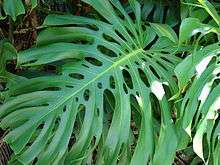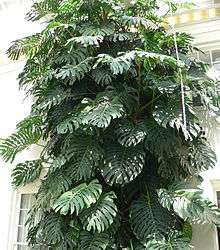Monstera
Monstera is a genus of 48 species of flowering plants in the arum family, Araceae, native to tropical regions of the Americas. The genus is named from the Latin word for "monstrous" or "abnormal", and refers to the unusual leaves with natural holes that members of the genus have.[3]
| Monstera | |
|---|---|
 | |
| Monstera deliciosa | |
| Scientific classification | |
| Kingdom: | Plantae |
| Clade: | Tracheophytes |
| Clade: | Angiosperms |
| Clade: | Monocots |
| Order: | Alismatales |
| Family: | Araceae |
| Subfamily: | Monsteroideae |
| Tribe: | Monstereae |
| Genus: | Monstera Adans.[1] |
| Synonyms[2] | |
| |
They are herbs or evergreen vines, growing to heights of 20 metres (66 ft) in trees, climbing by means of aerial roots which act as hooks over branches; these roots will also grow into the soil to help support the plant. Since the plant roots both into the soil and over trees, it is considered a hemiepiphyte.[4] The leaves are alternate, leathery, dark green, very large, from 25–90 centimetres (9.8–35.4 in) long (up to 130 centimetres (51 in) long in M. dubia) and 15–75 centimetres (5.9–29.5 in) broad, often with holes in the leaf blade. The flowers are borne on a specialised inflorescence called a spadix, 5–45 centimetres (2.0–17.7 in) long; the fruit is a cluster of white berries, edible in some species.

They are commonly grown indoors as houseplants. The best-known representative of the genus, Monstera deliciosa, is also cultivated for its edible fruit which tastes like a combination of banana and pineapple.
Species
As of July 2014 The Plant List recognises 48 accepted taxa (of species and infraspecific names):[5][6]
- Monstera acacoyaguensis Matuda
- Monstera acuminata K.Koch – Shingle plant
- Monstera adansonii Schott
- var. klotzschiana (Schott) Madison
- var. laniata (Schott) Madison
- Monstera alticola Croat
- Monstera amargalensis Croat & M.M.Mora
- Monstera aureopinnata Croat
- Monstera barrieri Croat, Moonen & Poncy
- Monstera bocatorana Croat & Grayum
- Monstera buseyi Croat & Grayum
- Monstera cenepensis Croat
- Monstera coloradensis Croat
- Monstera costaricensis (Engl. & K.Krause) Croat & Grayum
- Monstera deliciosa Liebm. – Ceriman, Swiss-cheese plant
- Monstera dissecta (Schott) Croat & Grayum
- Monstera dubia (Kunth) Engl. & K.Krause
- Monstera epipremnoides Engl.
- Monstera filamentosa Croat & Grayum
- Monstera florescanoana Croat, T.Krömer & Acebey
- Monstera fortunense Croat
- Monstera glaucescens Croat & Grayum
- Monstera gracilis Engl.
- Monstera jefense Croat
- Monstera kessleri Croat
- Monstera lechleriana Schott
- Monstera lentii Croat & Grayum
- Monstera luteynii Madison
- Monstera membranacea Madison
- Monstera minima Madison
- Monstera molinae Croat & Grayum
- Monstera obliqua Miq.
- Monstera oreophila Madison
- Monstera pinnatipartita Schott
- Monstera pirrense Croat
- Monstera pittieri Engl.
- Monstera planadensis Croat
- Monstera praetermissa E.G.Gonç. & Temponi
- Monstera punctulata (Schott) Schott ex Engl.
- Monstera siltepecana Matuda
- Monstera spruceana (Schott) Engl.
- Monstera standleyana G.S.Bunting
- Monstera subpinnata (Schott) Engl.
- Monstera tenuis K.Koch
- Monstera tuberculata Lundell
- var. brevinoda (Standl. & L.O.Williams) Madison
- Monstera vasquezii Croat
- Monstera xanthospatha Madison
Previously included:
- Monstera gigantea (Roxb.) Schott - Epipremnum giganteum (Roxb.) Schott
References
| Wikimedia Commons has media related to Monstera. |
| Wikispecies has information related to Monstera |
- "Genus: Monstera Adans". Germplasm Resources Information Network. United States Department of Agriculture. 2007-10-05. Archived from the original on October 19, 2012. Retrieved January 1, 2013.
- Kew World Checklist of Selected Plant Families
- Quattrocchi, Umberto (2000). CRC World Dictionary of Plant Names. 3 M-Q. CRC Press. p. 1723. ISBN 978-0-8493-2677-6.
- Eskov, A. K.; Zhukovskaya, N. V.; Bystrova, E. I.; Orlova, Yu. V.; Antipina, V. A.; Ivanov, V. B. (2016). "Growth of aerial roots with an extensive elongation zone by the example of a hemiepiphyte Monstera deliciosa". Russian Journal of Plant Physiology. 63 (6): 822–834. doi:10.1134/S1021443716060042.
- "Monstera". The Plant List. Retrieved July 10, 2014.
- "GRIN Species Records of Monstera". Germplasm Resources Information Network. USDA. Archived from the original on October 19, 2012. Retrieved January 1, 2013.